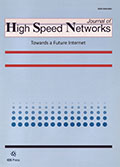Authors: Testa, Patrizia | Germoni, Angelo | Listanti, Marco
Article Type:
Research Article
Abstract:
Operating costs and scalability of nowadays telecommunication networks are largely impacted by energy consumption of network equipments. In packet switching devices it is especially due to packet processing, queuing, and input/output interface functionalities. Different approaches to reduce energy consumption in packet switches are emerging, some exploit under-laid optical bypass of transit traffic to reduce their capacity and interfaces, others simplify their operations or turn off some of their functionalities when unnecessary. The IEEE standardization body developed a standard on Energy Efficient Ethernet (IEEE P802.3az) that defined a mechanism allowing to de-activate the Physical layer elements during periods of low link
…utilization. It is based on a protocol that coordinates transitions to and from a lower power consumption mode without changing the link status and dropping frames. Time needed by such transitions is, however, comparable with packet transmission time; that makes energy efficiency of the method far from being proportional to interfaces unused capacity. Solutions proposed in the literature to improve EEE performance are mainly based on the buffer and burst approach, which, making the transmission non continuous, creates more opportunities for long sleeping period. Such solutions, however, if applied across the network, strongly impact packet delay requirements. In this paper, a traffic management mechanism that controls sleeping period to reduce EEE transitions overhead while meeting delay constraints of data flows is proposed. Starting from the consideration that in Ethernet network provisioning is static, i.e. service level agreement parameters of each flow are configured on switches output ports of its path via management plane at the set-up phase, the proposed method off-line determines, for each output port, if the activation of a dummy flow, associated to the quiet period, can provide power consumption reduction without impacting data flows delay requirements. On ports where the dummy flow is activated the sleeping period is triggered by the scheduler mechanism each time a dummy packet is served. A comparative analysis between the standard EEE, with and without the support of buffer and burst functionality, and the proposed method has been carried out in order to quantify the improvements in terms of energy efficiency and to assess its effectiveness in terms of Quality of Service (QoS).
Show more
Keywords: Energy efficiency, Ethernet, low power mode, Quality of Service
DOI: 10.3233/JHS-130462
Citation: Journal of High Speed Networks,
vol. 18, no. 4, pp. 239-249, 2012
Price: EUR 27.50





